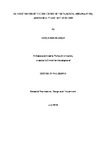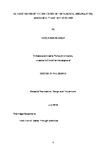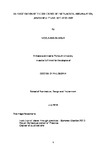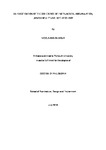An Investigation of the Coherence of Instrumental Accumulation, Using a Sculptural Methodology
| dc.contributor.supervisor | Miles, Malcolm | |
| dc.contributor.author | Gilmour, Nicola Ann | |
| dc.contributor.other | Faculty of Arts, Humanities and Business | en_US |
| dc.date.accessioned | 2014-03-17T15:46:04Z | |
| dc.date.available | 2014-03-17T15:46:04Z | |
| dc.date.issued | 2014 | |
| dc.identifier | 10093256 | en_US |
| dc.identifier.uri | http://hdl.handle.net/10026.1/2919 | |
| dc.description | Full version unavailable due to 3rd party copyright restrictions. | |
| dc.description.abstract |
This thesis questions the coherence of modes of fabrication that introduce materials to a living context, in forms that resist the processes of biological change. In doing so this project explores the ideologies embedded in fabrication that have led to this current position. The implications of an accumulation of materials being recognized as an autonomous object, and treated as if they are detached from their environment are also expanded. The sculptural methodology used to undertake this investigation has used the feature of materiality and it’s behaviours, of both human fabrication and the living environment, as a means to explore processes outside the limitations of specialist human categories of knowledge. The vocabularies of dematerialization, expansion and relational exchange in the critique of sculpture, have provided a starting point to articulate what is implied or “mapped out but not socially recognized”1 by the structure of specialist categories. The practice-based work that has driven this project, documents an extension of sculptural fabrication, which incorporates the literal processes of growth and erosion, illustrating a radical inclusivity of all living phenomena. Engaging with fabrication through this plural and complex methodology allows for a new valuing that recognizes accumulation as a result of employing reductive specialist categories and as inherently problematic for complex living systems. This identifies coherent fabrication as that which merges its engagement with processes of biological change and utility for humans. 1 Samuel Wagstaff. Jr., ‘Talking to Tony Smith’, Artforum 4, no 4, New York, December 1966 p.19, reproduced in Kastner, J. and Wallis, B. (1998) Land and Environmental Art London, New York: Phaidon p 27. | en_US |
| dc.language.iso | en | en_US |
| dc.publisher | Plymouth University | en_US |
| dc.subject | Coherent Fabrication | en_US |
| dc.subject | Anthropocentric Accumulation | |
| dc.subject | Biocentric Sculpture | |
| dc.subject | Post Oil Fabrication | |
| dc.subject | Dematerialisation | |
| dc.subject | Deep Ecology | |
| dc.title | An Investigation of the Coherence of Instrumental Accumulation, Using a Sculptural Methodology | en_US |
| dc.type | Thesis | |
| plymouth.version | Edited version | en_US |
| dc.identifier.doi | http://dx.doi.org/10.24382/4248 | |
| dc.identifier.doi | http://dx.doi.org/10.24382/4248 |
Files in this item
This item appears in the following Collection(s)
-
01 Research Theses Main Collection
Research Theses Main





